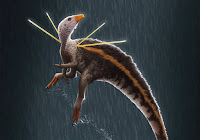 |
| Ubirajara jubatus Smyth, Martill, Frey, Rivera-Sylva & Lenz, 2020 |
Abstract
Discoveries of dinosaurs with integumentary structures over the last few decades have revolutionised our understanding of the phylogenetic relationships between birds and dinosaurs as well as the origin and evolution of feathers. A remarkable number of dinosaurs have been discovered with a diverse range of preserved integumentary structures. Several of these dinosaurs are adorned with elaborate integumentary structures that have been linked to behaviours including thermoregulation, egg incubation, and sexual display. Among Theropoda, such elaborate structures have only been previously recorded within Maniraptoriformes. However, elaborate monofilamentous structures are also present in some small ornithischians. The majority of theropods preserving integumental structures come from the Upper Jurassic and Lower Cretaceous of China or the Upper Jurassic of southern Germany, and all are of Laurasian origin. Herein, we describe a new genus and species of compsognathid theropod from the Lower Cretaceous (Aptian) Crato Formation of Northeast Brazil, representing the first Gondwanan non-avian theropod with preserved filamentous integumentary structures. It is also the first non-maniraptoran possessing elaborate integumentary structures that were most likely used for display. These include slender monofilaments associated with the base of the neck, increasing in length along the dorsal thoracic region where they form an impressive mane, as well as a pair of elongate, ribbon-like structures likely emerging from the shoulder. Such elaborate integumentary structures are hitherto unknown in any other dinosaur, although superficially similar elongate display feathers emerge from the carpal region of the male standardwing bird-of-paradise (Semioptera wallacii).
Keywords: Crato Formation, Lower Cretaceous, Dinosauria, Compsognathidae, Ubirajara jubatus, Integumentary structures
DINOSAURIA Owen 1842
THEROPODA Marsh 1881
COELUROSAURIA von Huene 1914
COMPSOGNATHIDAE Cope 1871
UBIRAJARA gen. nov.
Ubirajara jubatus gen. et sp. nov.
Etymology. Genus, Ubirajara, is a traditional Tupi name meaning
lord of the spear, in reference to the stiffened, elongate integumentary structures associated with the specimen. The specific epithet jubatus is from the Latin, meaning maned or crested.
Robert S.H. Smyth, David M. Martill, Eberhard Frey, Héctor E. Rivera-Sylva and Norbert Lenz. 2020. A Maned Theropod Dinosaur from Gondwana with Elaborate Integumentary Structures. Cretaceous Research. In Press. DOI: 10.1016/j.cretres.2020.104686








